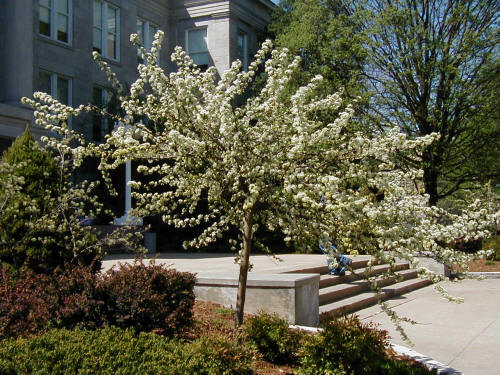Crabapple
Malus cv.
Rosaceae (Rose Family)
▲▼ white flowering cultivar and flowers
▲▼ red-flowering cultivar and flowers
▲▼ white/pink flowering cultivar and flowers
▲▼ pink-flowering cultivar and flowers

▲▼ var. sargentii and flowers
▲ weeping cultivar
▲ larger-fruited cultivar
▲ mature tree habit
▲▼ bark on young and older trees
▲ many trees had little damage after severe ice storm in Springfield, MO in 2007
Location on Missouri State University campus: on either side of MSU seal on east side of Carrington Hall; by west entrance to Karls Hall; many other locations
Malus
cv.: Crabapples
·
leaves
alternate, simple, deciduous, ovate, with serrate margins and short petiole;
dark green, glossy on top, lighter green and sometimes pubescent underneath;
1-3" long and 2/3 as wide
·
stems
slender, yellow-green to golden-brown to red to reddish-brown and
purplish-brown, light lenticels, glabrous or glaucous
·
bark
gray-brown to tan, scaly
·
grows
15-25' tall in upright oval to rounded to broad-spreading habit; often branching
within a few feet of the ground; most cultivars are grafted, some are rooted
cuttings
·
flowers white, pink to red; fruit is a red, orange, yellow, greenish or purplish
pome, 1/4" - 2" diameter (larger than 2" is considered an apple); flowers on
previous season's growth
·
prefers full sun and moist, well-drained soils with acid pH; prune out root
suckers and water sprouts from older branches before June; good to prune as with
apple trees to develop good branching habit for long life of tree
·
prone to many
diseases, particulary apple scab, cedar-apple rust, fireblight:
best to select
cultivars with some resistance to these diseases-- see textbooks, extension
guides and internet websites on crabapples for recommended cultivars
·
medium
growth rate
·
some
native to Missouri